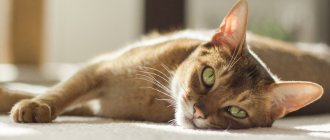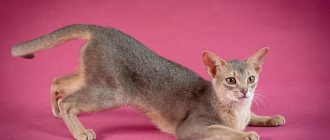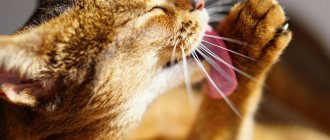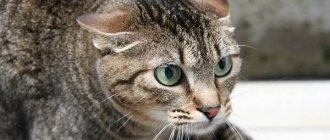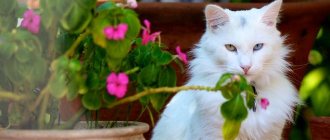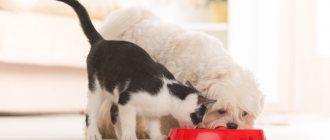Abyssinian cats are elegant short-haired animals with an original appearance and beautiful color. They combine majestic habits, predatory grace and canine devotion. Therefore, it is not surprising that every year the Abyssinians have more and more fans.
To find out who these unusual cats are suitable for, let's look at the main features of the breed.
Brief history of the breed
Abyssinians are ancient cats with mysterious origins. Scientists still cannot come to a consensus on where the breed came from:
- According to some, the Ethiopian trace is clearly visible in the history of the emergence of animals. Supporters of this theory are convinced that graceful cats appeared in Abyssinia (present-day Ethiopia) and from there came to Europe. As confirmation, they cite an English book published in the second half of the 19th century. On the pages of the publication there is a lithograph of a cat named Zulu, bought by Captain Barrett-Lenard after the end of the war between England and Abyssinia.
- Other experts are confident that the breed has Egyptian roots. As confirmation, they cite ancient figurines and frescoes depicting similar cats.
Whatever the true origin of the Abyssinians, they won fans a long time ago. They were first shown at a British exhibition in 1871.
Then they took an honorable third place out of 170 breeds present at the show. Abyssinian cats received official recognition and were included in the stud book in 1896.
Interesting Facts
Over the years of the breed’s existence, a lot of interesting things have happened to it:
- According to the CFA, in 2012, Abyssinian cats took second place in the popularity rating of Europe and America among short-haired breeds.
- After World War II, animals were on the verge of complete extinction. The breed was restored thanks to individuals that came to the United States in the early 1900s.
- The Abyssinian is one of the few cats that love water and tolerate bathing procedures without fear.
Breed description, standards, appearance
The Abyssinian is a strong and flexible cat with developed muscles and a harmoniously built body. Its chiseled silhouette and graceful movements give it a resemblance to a miniature puma.
The first standard for the Abyssinian cat breed was developed in 1889.
Dimensions and weight
Representatives of the breed are distinguished by their light, graceful build. Abyssinians do not have very developed sexual dimorphism. Therefore, the cat does not weigh much less than the male.
The average weight of an adult Abyssinian is 3-4.5 kg. Height at the withers: 30-32 cm (males), 26-28 cm (females).
Anatomical characteristics
A purebred Abyssinian cat must meet the following description:
- The head is wedge-shaped with rounded, smooth lines. The nose is straight and of medium length. The chin is rounded and well developed. Abyssinian males are allowed to have pronounced cheeks.
- The eyes are almond-shaped, widely set, slightly slanted. Colored amber or green. They have a black outline that visually continues the outline of the eyelids.
- The ears are large and set wide apart. Wide at the base, with rounded tips. Slightly tilted forward.
- The neck is graceful and elongated. The body is moderately stretched and proportional. The chest is rounded, the back is slightly arched.
- The limbs are long, thin with small oval paws and tightly pressed toes.
- The tail is long and thin. Tapers strongly towards the tip.
On a note. Abyssinian cats are divided into American and European lines. Representatives of the first are distinguished by a lighter and more graceful build.
Color and coat type of the Abyssinian cat
The entire body of the Abyssinian is covered with silky, soft, short hair, under which there is a tight-fitting down. On the back of a cat of this breed, the hair is slightly longer. But this is practically unnoticeable.
An important feature of the Abyssinian breed cat is its rich, warm coloring with an original tint. Each animal's hair has from 2 to 5 stripes of different shades. On the belly, chest and inner surface of the Abyssinian's limbs, the spine is lighter than on the tip of the tail, back and soles of the hind legs.
According to the breed standard, 4 color options are allowed:
- faun (light red);
- Sorel (chestnut or red with a red tint);
- ruddy or wild (orange-brown);
- blue (gray-blue with an orange tint).
Find out everything about the colors of Abyssinian cats in this article.
On a note. In some felinological systems, Abyssinians are recognized as having a chocolate or lilac color.
Possible breed defects
The disadvantages of the appearance of Abyssinian cats include:
- short limbs;
- small ears;
- lack of black edging around the eyes;
- short tail;
- Round eyes;
- spotted color;
- round or elongated head;
- light undercoat;
- Siamese type body type.
Abyssinian cats that have at least one of these characteristics cannot receive high marks from experts and cannot participate in breeding.
NBC colors. Review
Silver cats only have an undercoat that differs from tabby cats, with four ticking colors that are the same for both species. In all silver variations, the preferred undercoat color is white. The ticking matches the color of the coat and gives the overall appearance of a silver color. An ivory undercoat is also acceptable. Yellow or brown spots on the chest, belly, or inside of the legs are not desirable, although they are not considered a fault.
Silver: The ticking or dark stripes on the coat are black. The undercoat is white and silver. The tail is completely cinnamon color without rings. Eye and pad color: same as Ruddy. The nose is pink.
Silver-Cinnamon The ticking or dark stripes on the coat are the color of cinnamon. The undercoat is white and silver. The tail is completely black without rings. The color of the eyes and pads, as well as the nose: the same as Sorrel.
Blue-Silver: The ticking or dark stripes on the coat are blue-gray. The undercoat is white and silver. The tip of the nose and the color of the spine are like Blue. The color of the eyes and pads, as well as the nose: the same as Blue.
Fawn Silver: The ticking or dark stripes on the coat are fawn colors (pink beige).
The undercoat is white and silver. The tip of the nose and the color of the spine are like Fawn's. The color of the eyes and pads, as well as the nose: the same as Fawn. Abyssinian cat standards https://abyssin.net/wp-content/uploads/2016/03/cat10.jpg https://abyssin.net/wp-content/uploads/2016/03/cat10.jpg2018-10-08T22:35 :47+03:00 abyssinAbout the Abyssinian breed articlesWCF standard The body is muscular, medium size, strong, flexible, dense, of medium length. The tail is quite long, pointed, thick at the base. The limbs are sinewy, long and slender. The paws are narrow and oval. The head is wedge-shaped, of medium proportions, soft contour, a slight notch at the transition to the muzzle is desirable. When viewed from the front, the muzzle is rounded and fits into a parabola, pointing downwards. Strong...abyssinPhilip Sirotin [email protected] Cattery
Character and temperament
Although the Abyssinian cat looks like a small predator, its habits do not at all correspond to its “wild” appearance. Intelligent and smart animals are distinguished by a playful, active temperament and innate neatness. They are very affectionate, patient and rarely release their claws.
The developed sense of self-esteem and independent character of the Abyssinian cat will not allow her to tolerate disdainful treatment of herself. The animal needs close communication with humans and, if there is a lack of attention, can become depressed.
Read: “What names are suitable for Abyssinians.”
The energetic Abyssinian will not sit on his hands all the time, but will gladly take part in active games.
On a note. An important characteristic of the Abyssinians is loyalty to their owners. Representatives of this breed follow their owners everywhere. That is why Abyssinian cats are often compared to dogs.
Breed and children
Abyssinian cats are quite good with children. But only on condition that the kids do not try to offend them. The wayward Abyssinians do not tolerate familiarity. Therefore, the child must understand that a cat cannot be treated roughly or cruelly. And it is better not to leave very young children alone with an Abyssinian.
On a note. Although Abyssinians are not the most aggressive cats, they can hiss, growl and extend their claws in stressful situations.
Breed and other animals
Sociable and intellectually developed, Abyssinians get along well with a variety of pets. They get along well with medium and large sized animals. But Abyssinian cats really hunt for rodents.
Advantages and disadvantages
Experts highlight the following advantages of the breed:
- sophistication in every movement;
- smart;
- active and inquisitive;
- friendly with children and other animals;
- rare coat color, different from its relatives.
The disadvantages of Abyssinians include:
- naturally cautious;
- do not like to sit on the owner’s lap, preferring elevated places in the apartment;
- love to play mischief;
- They cannot be without their owner for a long time.
How to choose the right Abyssinian cat kitten
It is better to buy a kitten of this breed from a specialized nursery or from a professional breeder with a good reputation. Before making a transaction, you need to make sure that the baby has the entire package of documents confirming its origin and vaccinations, and that the animal itself complies with the standard.
By the age of three months, Abyssinian kittens already have characteristic ticking and black edging of the eyelids. They do not have light undercoat, stripes or spots on their coat.
You also need to pay attention to the character and behavior of the kids. Abyssinian kittens are not afraid of people and do not show aggression. They are actively interested in everything that happens around them and enjoy playing.
Healthy Abyssinian kittens have shiny fur, clear eyes, soft bellies, clean ears and a confident gait.
Kitten care
It is advisable to take a little Abyssinian from his mother no earlier than he is 3 months old. To make the kitten comfortable in a new home, purchase for it in advance:
- bowls for water and food;
- toys;
- scratching post;
- tray and filler;
- bed or house;
- carrying bag;
- hygiene products (toothpaste, shampoo, etc.).
By the time they move to their new owners, Abyssinian kittens, as a rule, are already accustomed to the tray and scratching post. But it is possible that they will need some time to adapt.
Mr. Cat Warns: Cat Allergy
Abyssinian cats have less fur than other breeds, so they practically do not shed. But this does not make them hypoallergenic, since in people allergic reactions can be caused not only by fur, but by the saliva and urine of the animal.
In terms of the internal structure and functioning of glands and hormones, Abyssinians are no different from their relatives - they also actively lick themselves, and the urine of males is richer in smell than the urine of females. Therefore, if the future owner is allergic to cats of other breeds or ordinary outbreds, then it can also manifest itself in Abyssinians.
Care and maintenance
Abyssinians love warmth very much, so they are not designed to live outside. The room where a representative of this breed is kept must have a comfortable air temperature. It is with the heat-loving nature of the Abyssinians that the peculiarities of caring for such pets are associated.
Learn how to care for an Abyssinian kitten.
The fact is that Abyssinian cats can sit on heating devices for a long time and often burn their paws. Therefore, it is better to place their bed or hammock near the radiator so that the animals can comfortably enjoy the warmth.
Hygiene procedures
In order for the Abyssinian to look neat, he is provided with regular grooming:
- The cat's eyes and ears are wiped weekly with a moistened cotton pad and inspected for any unusual discharge.
- The Abyssinian's teeth are cleaned several times a month with a silicone brush and a special paste that does not foam. This simple procedure will help prevent the formation of plaque and stone.
- The claws of an Abyssinian cat are shortened twice a month with a nail clipper, trying to do this as carefully as possible.
Grooming
It is enough to comb an Abyssinian cat once a week. This is best done with a special rubber glove brush. During the molting period, the procedure is carried out 2-3 times a week using a furminator.
The Abyssinian cat is not often bathed. To maintain the cleanliness of the coat, it is enough to arrange bathing procedures once a quarter. The well-moistened coat of the Abyssinian is lathered with a special shampoo, lightly massaged and washed off with warm water. The washed pet is wiped dry with a towel.
Tray
Abyssinian cats love to dig. Therefore, despite their small size, they need spacious trays with high sides. It is better to use sawdust pellets as a filler.
Food prohibitions
In addition to healthy foods, there are also those that are strictly not recommended to be included in food:
- Chicken and fish bones, since cats cannot chew them, and the bone can injure both the gum and tooth.
- Raw meat - duck, goose, pork. Fatty lamb is also contraindicated.
- Smoked meats in any form, as well as seasonings, spices and salt.
- Marinades and fried foods.
- All legumes are excluded from vegetables: peas, soybeans, beans, and potatoes.
Read about what cats and kittens should not eat.
Uncontrolled use of the above products affects the pet's immunity and the appearance of its coat - it becomes dull and dandruff may appear. Legumes can cause gas and stomach upset.
If the cat receives only natural food, then it is necessary to additionally introduce vitamins and supplements, since ordinary products do not contain the full range of necessary substances.
Also read the article about whether cats can be fed raw foods.
Feeding an Abyssinian cat
In order for a four-legged pet to develop properly and look good, it is provided with a balanced diet.
Complete diet
With a natural type of feeding, the basis of the Abyssinian cat’s menu should be meat food. Turkey, chicken, rabbit, veal or beef are used as a source of animal protein. Meat for a cat of this breed is given both boiled and raw. In the latter case, it is first kept in the freezer for at least 7 days.
In addition to meat, the Abyssinian diet includes:
- vegetables;
- dairy products;
- eggs;
- sea fish;
- offal.
Pork, sweets, smoked meats and any leftovers from the master’s table must be excluded from the Abyssinian cat’s menu.
Read in detail about: “How to feed an Abyssinian correctly.”
When fed dry, an animal of this breed is given premium or super-premium products, which do not contain any dubious additives such as soy or preservatives.
Best suited for Abyssinian cats:
- Orijen;
- Acana;
- Arden Grange;
- Hills;
- Royal Canin.
Important. When selecting food, be sure to take into account the age and health status of the Abyssinian.
Feeding frequency
A kitten eats less and more often than an adult Abyssinian. Therefore, the number of meals directly depends on the age of the animal:
- up to 4 months – 6 times a day;
- 4-5 months – 5 times a day;
- 5-9 months – 4 times a day;
- 9-12 months – 3 times a day.
As soon as the Abyssinian turns 1 year old, he is transferred to double feeding.
Vitamins and minerals
When feeding natural products, the Abyssinian cat is given additional vitamin supplements twice a year. They replenish the deficiency of valuable substances and have a beneficial effect on the pet’s health.
Vitamin and mineral complexes help strengthen the immune system, improve the animal’s coat and strengthen its teeth.
Good for Abyssinian cats:
- Canina Canivita;
- 8 in 1 Excel Brewer'sYeast;
- PolidexImmunity.
On a note. An excess of vitamins is no less dangerous than their deficiency. Therefore, before you buy them for an Abyssinian, the cat needs to be shown to a veterinarian.
Health of Abyssinians
The excellent health indicators cannot be overestimated. Possible diseases include gingivitis, which develops as a result of an incorrectly selected diet. Regular teeth brushing will help solve the problem.
global $ads_google; //data-ad-slot=”2475549904″ $ads_google = empty($ads_google) ? false : true; ?> if ($ads_google == false) {?> $ads_google = true; ?> } ?>
Some cats develop a kidney disease called renal amyloidosis. The disease is not considered a hallmark of the health of this particular breed. In nurseries, when such heredity is identified, they approach the selection of breeding representatives strictly, not allowing the disease to be transmitted to the descendants of culled cats. It is also necessary to get all recommended vaccinations on time.
If you want to take part in the breeding of the breed, the pets are mated. After 63-65 days of quiet pregnancy, kittens will be born. The specific gestation period depends on heredity and the number of fruits. During childbirth, the owner must support the pet and provide her with the necessary assistance.
If offspring are not planned, it is better to castrate or sterilize the animal. The age of surgery for cats is 6-9 months, and for cats 7-12 months.
Timely vaccinations and a competent approach to maintenance will allow the cat to live next to its owner for many years. The life expectancy of an Abyssinian is 12-15 years .
Education and physical activity
Abyssinian cats are curious and energetic animals. They try to explore every corner of the house and love to climb on cabinets. To give the Abyssinians the opportunity to splash out their accumulated energy, they are equipped with a play complex with numerous shelves and ladders on which the pet can climb and jump.
Representatives of this breed are distinguished by high intelligence and extraordinary cleanliness. They quickly get used to the rules established in the house and remember their own nickname.
Abyssinians are able to learn commands and can repeat the actions of their owners.
Factors that will affect the life expectancy of an Abyssinian
Summarizing the section on how long a cat of the Abyssinian breed lives, we note that it depends not only on genetics, but also on the following factors:
- a proper diet that excludes obesity, but includes the vitamins and microelements the animal needs;
- regular visits to the veterinarian, guaranteeing the opportunity to prevent dangerous diseases;
— compliance with hygiene rules: proper and systematic care of teeth, fur, claws;
— the most comfortable conditions for an active life;
- attention and love.
To the list you can add sterilization of the animal, which helps preserve its energy resource and health.
Knowing well the needs of the generally unpretentious Abyssinian, providing him with the attention he needs, noticing illnesses in time, the owner can enjoy the company of a pet for 20 long years.
Read all about the Abyssinian breed in the Main article
Vaccinations and antiparasitic treatment
To prevent an Abyssinian cat from becoming a victim of viral diseases, it must be vaccinated. The first vaccination is given to him at the age of 7-8 weeks. The little Abyssinian is injected with a complex drug that develops immunity:
- to calcivirus;
- rhinotracheitis;
- panleukopenia.
At 12-13 weeks, an Abyssinian kitten is vaccinated against the same diseases and rabies. In the future, the Abyssinian is vaccinated annually.
The animal is regularly treated for fleas and worms:
- Anthelmintic drugs are given to the Abyssinian once every six months, repeated every 10-14 days.
- Fleas are removed from cats using drops or shampoos. And if the Abyssinian goes outside, she is additionally put on an anti-parasitic collar.
Reproduction
Mating of Abyssinians is allowed only within the breed, and the color of the animals must also be taken into account. A cat is ready to bear full-fledged offspring only after a year, despite the fact that estrus comes earlier - at 6-7 months.
Mating of Abyssinians is allowed only within the breed
The meeting of the animals is prepared on the territory of the male. The cat is left for a day or two. Before this, a medical examination of both animals is carried out, vaccinations and deworming are given in advance.
Sterilization and castration
Abyssinians who are not of breeding value are best sterilized. Such an operation will protect the animal from the possible development of purulent inflammation of the uterus and other health problems. An Abyssinian cat can be sterilized after puberty and only in a veterinary clinic.
Important. Too early surgery is fraught with problems with the genitourinary system. Therefore, it is advisable to carry it out after the Abyssinian turns 5-6 months old.
Let's sum it up
Abyssinian cats rightfully occupy one of the first places in many different ratings of the best breeds, since they combine everything: intelligence, beauty, devotion, and affection for people. , you're buying a friend, not an animal that won't want anything to do with you. In the process of living together, a bond is formed between the cat and the owner, which will be noticeable to everyone around. When getting an Abyssinian cat, think about whether you can justify her trust and provide her with the necessary living conditions.
The Abyssinian cat is a wonderful companion
Pros and cons of the breed
Like cats of any other breed, Abyssinians have both advantages and disadvantages.
| pros | Minuses |
| Cleanliness | Tendency to depression |
| Friendliness | High probability of infertility in cats |
| Playfulness |
Abyssinian cats are beautiful and very active animals that do not require special care. Representatives of the breed quickly get used to their owners and try to follow on their heels. Therefore, Abyssinians are the best choice for those who like loyal and sociable pets.
Conclusions about the breed
What can an Abyssinian cat conquer? This breed is delightful for its appearance, smooth lines of a strong healthy body, and pronounced affectionate and sociable character.
A person who brings an Abyssinian into the house will immensely love such a smart and interesting cat, because she manages to find a common language with both the child and other pets.
This wonderful breed has good health, amazing silky hair and does not burden the owner with excessive demands on grooming.
